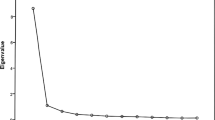Abstract
The aim of this study was to evaluate the long-lasting effect of pelvic floor muscle training (PFMT) in women with urinary incontinence after stroke measured by quality of life parameters. Twenty-four (24/24) women with urinary incontinence after stroke, who had completed a prospective, randomised controlled and single-blinded trial evaluating the effect of 12 weeks PFMT, were included in this follow-up study. The follow-up assessments were done by telephone interview 6 months after the intervention. The effect was evaluated by The Short Form 36 (SF-36) Health Survey Questionnaire and Incontinence Impact Questionnaire (IIQ). Twenty-four subjects completed the study. In the treatment group, the SF-36 showed a trend to a long-lasting effect in one of the eight domains and the IIQ showed a tendency to decreased impact of UI in two sub-scales compared to the control group. Our data indicated that PFMT may have a long-lasting effect measured by quality of life parameters.

Similar content being viewed by others
References
Britain KR, Peet SM, Castleden CM (1998) Stroke and incontinence. Stroke 29:524–528
Barrett JA (2002) Bladder and bowel problems after stoke. Clin Gerontol 12:253–267
Thomas LH, Barrerr J, Cross S, French B, Leathley M, Sùtton C, Watkins C (2005) Prevention and treatment of urinary incontinence after stroke in adults. The Cochrane Database of Syst Rev:CD004462; DOI 10.1002/14651858
Kelleher CJ, Cardozo LD, Toozs-Hobson PM (1995) Quality of life and urinary incontinence. Curr Opin Obstet Gynecol 7:404–408
Thomas TM, Plymat KR, Blamin J, Meade TW (1980) Prevalence of urinary incontinence. BMJ 281:1243–1245
Brittain KR, Perry SI, Peet SM et al (2000) Prevalence and impact of urinary symptoms among community-duelling stroke survivors. Stroke 31:886–891
Patel M, Coshall C, Rudd AG, Wolfe CD (2001) Natural history and effects on 2-year outcomes of urinary incontinence after stroke. Stroke 32(1):122–127
Williams A (1993) Caregivers of persons with stroke: their physical and emotional well-being. Qual Life Res 2:213–220
Abrams P, Blaivas JG, Stanton SL, Andersen JT (1990) The Standardisation of terminology of lower urinary tract function recommended by the International Continence Society. Int Urogynecol J 1:45–58
Hay-Smith EJC, Bø K, Berghmans LCM et al (2001) Pelvic floor muscle training for urinary incontinence in women. Cochrane database Syst Rev (1):CD001407
Bø K (1990) Pelvic floor muscle exercise for the treatment of female stress urinary incontinence. Methodological studies and clinical results. Doctorial thesis, The Norvegian University of Sport and Physical Education
Nygaard I, Holcomb R (2000) Reproducibility of seven-day voiding diary with stress urinary incontinence. Int Urogynecol J 11:15–17
Tibaek S, Gard G, Jensen R (2005) Pelvic floor muscle training is effective in women with urinary incontinence after stroke. Neurourol Urodyn 24(4):348–357
Tibaek S, Jensen R, Lindeskov G, Jensen M (2004) Can quality of life be improved by pelvic floor muscle training in women with urinary incontinence after ischemic stroke? A randomised, controlled and blinded study. Int Urogynecol 15:117–123
WHO Task Force on Stroke and other cerebrovascular Disorders (1989) Stroke—1989: recommendation on stroke prevention, diagnosis and therapy. Stroke 20:1407–1431
Folstein MF, Folstein SE, McHugh PR (1976) “Mini-Mental State” a practical method for grading the cognitive state of the patients for the clinicians. Psychol Med 6:551–553
Ware JE, Sherbourne CD (1992) The MOS 36-items from health survey (SF-36). I Conceptual framework and item selection. Med Care 30:472–483
Garrat AM, Ruta DA, Abdalla MI, Buckingham JK, Russel IT (1993) The SF-36 health survey questionnaire: an outcome measurement suite for routine use within the NHS. BMJ 306:1440–1444
Anderson C, Laubscer S, Burn R (1996) Validation of the Short Form 36 (SF-36) health survey questionnaire among stroke patients. Stroke 27:1812–1816
Shumaker SA, Wyman JF, Uebersax JS, McClish D, Fantl JA (1994) Health related quality of life measures for women with urinary incontinence: the incontinence impact questionnaire and the urogenital distress inventory. Qual Life Res 3:291–306
Harari D, Norton D, Lockwood L, Swift C (2004) Treatment of constipation and facal incontinence in stroke patients. Stroke 35:2549–2555
Pickard A S, Johnson J A, Penn A, Lau F, Noseworthy T (1999) Reliability of SF-36 summary scores by the SF-12 in stroke patients. Stroke 30:1213–1217
Foster A, Smith J, Young J, Knapp P, House A, Wright J (2001) Information provision for stroke patients and their caregivers. The Cochrane Database of Syst Rev:DC001919
Blaivas JG, Appell RA, Fantl AF, Leach G, McGuire EJ, Resnick NM, et al (1997) Standards of efficacy for evaluation of treatment outcomes in urinary incontinence: recommendation of the urodynamic society. Neurourol Urodyn 16:145–147
Lyons RA, Wareham K, Lucas M, Price D, Williams J, Hutchings HA (1999) SF-36 scores vary by method of administration: implications for study design. J Public Health Med 21(1):41–45
Acknowledgements
Financial support was provided by the following sources: The Foundation of Danish Physiotherapists Research, The Foundation of 1870 and Direktør Jacob Madsen og hustrus Fond. The authors are also very grateful to Mette Jensen, Grethe Lindskov (GL) and Inge Sørensen who all had contributed significantly to this work.
Author information
Authors and Affiliations
Corresponding author
Additional information
An erratum to this article can be found at http://dx.doi.org/10.1007/s00192-007-0496-4
Rights and permissions
About this article
Cite this article
Tibaek, S., Gard, G. & Jensen, R. Is there a long-lasting effect of pelvic floor muscle training in women with urinary incontinence after ischemic stroke?. Int Urogynecol J 18, 281–287 (2007). https://doi.org/10.1007/s00192-006-0137-3
Received:
Accepted:
Published:
Issue Date:
DOI: https://doi.org/10.1007/s00192-006-0137-3




